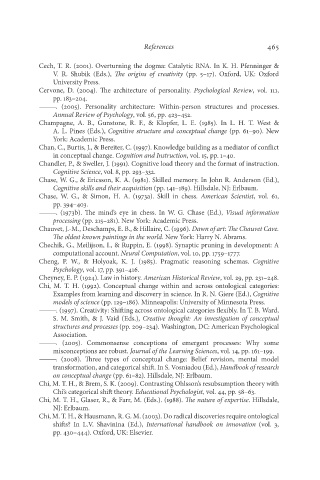Page 482 - Deep Learning
P. 482
References 465
Cech, T. R. (2001). Overturning the dogma: Catalytic RNA. In K. H. Pfenninger &
V. R. Shubik (Eds.), The origins of creativity (pp. 5–17). Oxford, UK: Oxford
University Press.
Cervone, D. (2004). The architecture of personality. Psychological Review, vol. 111,
pp. 183–204.
———. (2005). Personality architecture: Within-person structures and processes.
Annual Review of Psychology, vol. 56, pp. 423–452.
Champagne, A. B., Gunstone, R. F., & Klopfer, L. E. (1985). In L. H. T. West &
A. L. Pines (Eds.), Cognitive structure and conceptual change (pp. 61–90). New
York: Academic Press.
Chan, C., Burtis, J., & Bereiter, C. (1997). Knowledge building as a mediator of conflict
in conceptual change. Cognition and Instruction, vol. 15, pp. 1–40.
Chandler, P., & Sweller, J. (1991). Cognitive load theory and the format of instruction.
Cognitive Science, vol. 8, pp. 293–332.
Chase, W. G., & Ericsson, K. A. (1981). Skilled memory. In John R. Anderson (Ed.),
Cognitive skills and their acquisition (pp. 141–189). Hillsdale, NJ: Erlbaum.
Chase, W. G., & Simon, H. A. (1973a). Skill in chess. American Scientist, vol. 61,
pp. 394–403.
———. (1973b). The mind’s eye in chess. In W. G. Chase (Ed.), Visual information
processing (pp. 215–281). New York: Academic Press.
Chauvet, J.-M., Deschamps, E. B., & Hillaire, C. (1996). Dawn of art: The Chauvet Cave.
The oldest known paintings in the world. New York: Harry N. Abrams.
Chechik, G., Meilijson, I., & Ruppin, E. (1998). Synaptic pruning in development: A
computational account. Neural Computation, vol. 10, pp. 1759–1777.
Cheng, P. W., & Holyoak, K. J. (1985). Pragmatic reasoning schemas. Cognitive
Psychology, vol. 17, pp. 391–416.
Cheyney, E. P. (1924). Law in history. American Historical Review, vol. 29, pp. 231–248.
Chi, M. T. H. (1992). Conceptual change within and across ontological categories:
Examples from learning and discovery in science. In R. N. Giere (Ed.), Cognitive
models of science (pp. 129–186). Minneapolis: University of Minnesota Press.
———. (1997). Creativity: Shifting across ontological categories flexibly. In T. B. Ward,
S. M. Smith, & J. Vaid (Eds.), Creative thought: An investigation of conceptual
structures and processes (pp. 209–234). Washington, DC: American Psychological
Association.
———. (2005). Commonsense conceptions of emergent processes: Why some
misconceptions are robust. Journal of the Learning Sciences, vol. 14, pp. 161–199.
———. (2008). Three types of conceptual change: Belief revision, mental model
transformation, and categorical shift. In S. Vosniadou (Ed.), Handbook of research
on conceptual change (pp. 61–82). Hillsdale, NJ: Erlbaum.
Chi, M. T. H., & Brem, S. K. (2009). Contrasting Ohlsson’s resubsumption theory with
Chi’s categorical shift theory. Educational Psychologist, vol. 44, pp. 58–63.
Chi, M. T. H., Glaser, R., & Farr, M. (Eds.). (1988). The nature of expertise. Hillsdale,
NJ: Erlbaum.
Chi, M. T. H., & Hausmann, R. G. M. (2003). Do radical discoveries require ontological
shifts? In L.V. Shavinina (Ed.), International handbook on innovation (vol. 3,
pp. 430–444). Oxford, UK: Elsevier.

